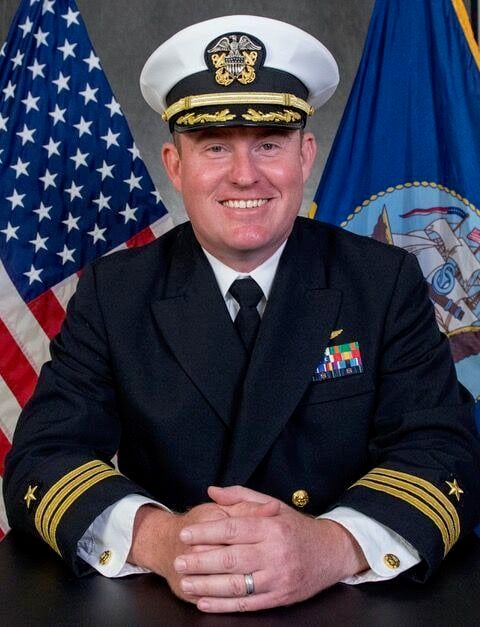CORPUS CHRISTI, Texas – A Mandeville, Louisiana, native is supporting the training of naval aviation personnel and air operations.
“I joined the Navy to serve my country,” said Hawkins. “I wanted to do something different than all of my peers in high school. I had the opportunity to attend the U.S. Naval Academy. I always wanted to be a pilot since I was very young. The Navy gave me that opportunity and continues to give me that opportunity.”
Skills and values learned in the Navy are similar to those found in Mandeville.
“I learned hard work and support for the military and country from my hometown,” said Hawkins. “My appreciation for the Navy started at air shows I watched at both Naval Air Station New Orleans and Naval Air Station Pensacola.”
Hawkins serves as a Navy pilot and the executive officer with Naval Air Station (NAS) Corpus Christi, Texas. NAS Corpus Christi provides service and facilities support of Chief of Naval Air Training and Corpus Christi Army Depot.
“As the executive officer for NAS Corpus Christi, I do all the behind the scenes hard work of keeping an installation on track and on mission,” said Hawkins. “I am also in training to be a T-6 Texan flight instructor.”
The air training program focuses on the increased complexity of today’s aircraft. After successfully completing the rigorous program, naval aviators earn their coveted “Wings of Gold.”
After graduation, pilots continue their training to learn how to fly a specific aircraft, such as the Navy’s F/A-18 Super Hornet fighter attack jet, the F-35 Lightning strike fighter jet or the MH-60 Seahawk helicopter. These aircraft take off from and land on Navy aircraft carriers at sea.
Navy aircraft carriers are designed for a 50-year service life. When the air wing is embarked, the ship carries more than 70 attack fighter jets, helicopters and other aircraft, all of which take off from and land aboard the carrier at sea. With more than 5,000 sailors serving aboard, the aircraft carrier is a self-contained mobile airport.
Aircraft carriers are often the first response to a global crisis because of their ability to operate freely in international waters anywhere on the world’s oceans.
Since USS Langley’s commissioning 100 years ago, the nation’s aircraft carriers and embarked carrier air wings have projected power, sustained sea control, bolstered deterrence, provided humanitarian assistance and disaster relief, and maintained enduring commitments worldwide.
“The aircraft carrier is our U.S. Navy’s centerpiece, our flagship, and a constant reminder to the rest of the world of our enduring maritime presence and influence,” said Rear Adm. James P. Downey, USN, Program Executive Officer (PEO) Aircraft Carriers. “These ships touch every part of our Navy’s mission to project power, ensure sea control, and deter our adversaries.”
With more than 90 percent of all trade traveling by sea, and 95 percent of the world’s international phone and internet traffic carried through fiber optic cables lying on the ocean floor, Navy officials continue to emphasize that the prosperity and security of the United States is directly linked to ready sailors and a strong Navy.
“Maintaining the world’s best Navy is an investment in the security and prosperity of the United States, as well as the stability of our world,” said Adm. Mike Gilday, Chief of Naval Operations. “The U.S. Navy—forward deployed and integrated with all elements of national power—deters conflict, strengthens our alliances and partnerships, and guarantees free and open access to the world’s oceans. As the United States responds to the security environment through integrated deterrence, our Navy must continue to deploy forward and campaign with a ready, capable, combat-credible fleet.”
erving in the Navy means Hawkins is part of a team that is taking on new importance in America’s focus on rebuilding military readiness, strengthening alliances and reforming business practices in support of the National Defense Strategy.
“We’re the only service in the world that can bring 80-plus war planes and an airport with supporting ships to 70 percent of the world,” said Hawkins. “No other country can do that like the U.S. Navy.”
Hawkins has many opportunities to achieve accomplishments during military service.
“My proudest accomplishment is providing disaster relief to Panay Island, Philippines, and post-Hurricane Matthew recovery efforts to Haiti,” said Hawkins.
As Hawkins and other sailors continue to perform missions, they take pride in serving their country in the United States Navy.
“Serving in the Navy is a very fulfilling and rewarding experience,” added Hawkins. “I do this for my family, friends and for everyone who would love to join the military but does not have the opportunity to do so.”
Hawkins is grateful to love ones for helping make a Navy career possible.
“I would like to thank my parents for encouraging me and helping me to join and succeed in naval service,” added Hawkins. “I’d also like to thank my wife and kids for allowing me to be away from time to time in order to serve my country.”



Comments
No comment